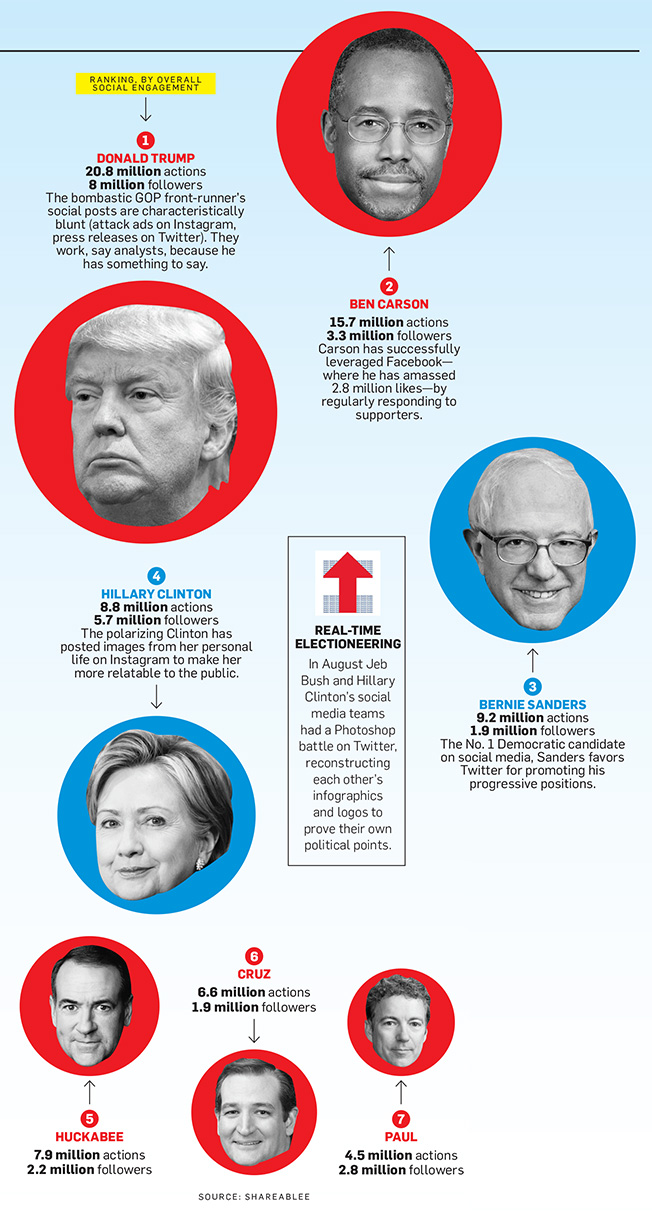In 2008 Barack Obama changed how presidential candidates use social media during what people called the Facebook Election. Now during any campaign, it is assumed that all the candidates will use social media—and that they’ll be active on many platforms.
 According to Pew Research Center, substantially more Americans are following political candidates on social media. Just having followers isn’t enough to win an election though.
According to Pew Research Center, substantially more Americans are following political candidates on social media. Just having followers isn’t enough to win an election though.
 The graphic above from Adweek shows the social engagement of the candidates (as of September 2015). These candidates face the challenge of trying to actively engage with voters in social media settings. Two ways look at this issue are from the perspectives of Agenda Setting and Gatekeeping Theory.
The graphic above from Adweek shows the social engagement of the candidates (as of September 2015). These candidates face the challenge of trying to actively engage with voters in social media settings. Two ways look at this issue are from the perspectives of Agenda Setting and Gatekeeping Theory.
Agenda Setting
Agenda setting theory explains that the media do not tell you what to think, but they do tell you what to think about. The media shape and filter reality–they do not directly reflect it. The more the media focus on a particular story, the more it is perceived as relevant by the viewers.
So many "politically correct" fools in our country. We have to all get back to work and stop wasting time and energy on nonsense!
— Donald J. Trump (@realDonaldTrump) August 8, 2015
A Politico article from August 2015 straight up says in the title, “Trump is Setting the GOP Agenda.” Donald Trump has said some very controversial things already in this election cycle, which leads to more coverage of him in the media. Even though people may not agree with what he is saying, he is still being talked about. According to agenda setting, the more he shows up in the media, the more significant he is going to be perceived as. It also brings the issues that he talks about to the top of the discussion. The republican candidates were not talking that much about immigration until Trump made insensitive comments about it. Now it is an important issue that all the candidates address.
Take for example this (slightly childish) Twitter interaction between Hillary Clinton and Jeb Bush:
Cost won't be a barrier to an education. Debt won't hold you back. Read Hillary's plan: http://t.co/A4pWb3fOf4 pic.twitter.com/KVyr8SlSVn
— Hillary Clinton (@HillaryClinton) August 10, 2015
@HillaryClinton pic.twitter.com/m6LAHYCLok
— Jeb Bush (@JebBush) August 10, 2015
.@JebBush Fixed it for you. pic.twitter.com/d4q9EWpXCA
— Hillary Clinton (@HillaryClinton) August 10, 2015
.@HillaryClinton fixed your logo for you. pic.twitter.com/141nXHQe4Z
— Jeb Bush (@JebBush) August 11, 2015
Although this might not be the most mature way to discuss politics, it did earn Clinton and Bush extra news coverage. A search on Google News shows that at least 913 articles were written about this one incident. It brought both candidates—as well as the issue of student debt—to the public’s attention. When it comes to social media, I recommend that presidential candidates use it as a platform for have their issues heard. The more they can draw attention to the issues they are concerned with, the more people will see that issue as important. They should spark some conversation with intriguing social media posts to get people talking. This way they are creating news instead of just being passively part of it.
Gatekeeping:
In gatekeeping theory the idea is that there are gatekeepers in our society who control the flow of information. They determine what messages get passed on which do not. It is all about how has the access to power to decide which stories get told. It’s a way of filtering the conversation.
With social media, presidential candidates can be seen as their own gatekeepers. They control what they want to post, and what information they decide to share with their followers. One way candidates should use social media to their advantage is to provide a “behind-the-scenes” look of their campaign. It can make voters feel like they are more connected to the candidates because they are seeing them in a natural way. Previously, a news story had to go through many gatekeepers but now candidates can directly share their own news, stories, photos, and opinions on social media. I recommend that the candidates keep this in mind as they decide how to share their messages. Sometimes it is better for them to be able to share their own words on social media than to have it reported on by traditional media sources first. It also gives the candidates the chance to directly talk to voters. I think they should use social media to target key influencers that are gatekeepers to their communities who can then further spread the message.
Take for example Hillary Clinton’s first Instagram post:
It shows Clinton’s trademark pantsuits and how she is able to poke fun at herself, which could help her been seen as more relatable. By avoiding traditional gatekeepers in media outlets, she is able to directly connect with Americans and show them what she wants to.
Here is an example of targeting voters through an influencer:
"I have decided to endorse Bernie Sanders, I #FeelTheBern" says @margaretcho in interview – https://t.co/Ora95BYptF pic.twitter.com/GgZndrRee0
— CA for Bernie (@CA4Bernie) November 3, 2015
Social media has been especially important to democratic candidate Bernie Sanders. Early in the election cycle, most of the media attention for the democratic race was focused on Hillary Clinton. Sanders drew a large crowd on social media and got his messages out that way instead of relying on the mainstream media coverage and going through all those gatekeepers. Now his hashtag #FeeltheBern is quite popular.